Key takeaways:
- Alternatives to incarceration, such as community service and restorative justice, promote rehabilitation and personal growth over punishment.
- The anti-death penalty movement addresses systemic inequities in the justice system and advocates for humane approaches to crime.
- Mental health treatment is essential in addressing root causes of criminal behavior, potentially reducing recidivism through support and therapy.
- Community engagement and accountability foster relationships that aid reintegration and encourage offenders to reflect on their actions.
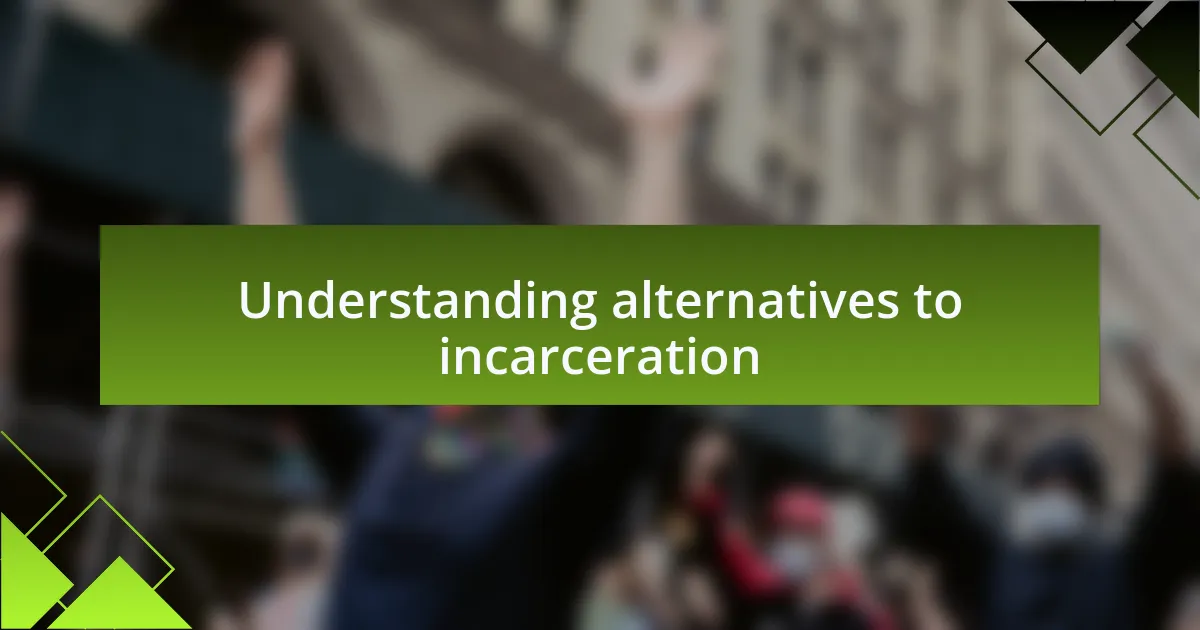
Understanding alternatives to incarceration
When I think about alternatives to incarceration, I often reflect on community service programs. I’ve seen firsthand how a young person, who once made a poor choice, found redemption through giving back to their community. This approach not only helps rebuild trust but fosters a sense of responsibility, allowing individuals to make amends and learn valuable life skills.
Restorative justice is another powerful alternative that intrigues me. It strikes a chord because it emphasizes healing over punishment. Imagine a victim and an offender coming together to discuss the impact of the crime—this process can lead to genuine understanding and forgiveness. Can you picture the potential for transformation? I believe it offers both parties a chance to grow, rather than defining their lives by a label of criminality.
Moreover, mental health treatment and rehabilitation programs resonate deeply with the idea that many individuals enter the justice system struggling with untreated issues. I recall attending a seminar where a former inmate shared their journey of overcoming addiction through therapy and support. It made me question how many lives could be changed if we prioritized treatment over confinement. Wouldn’t it be more humane and effective to address the root causes of crime?
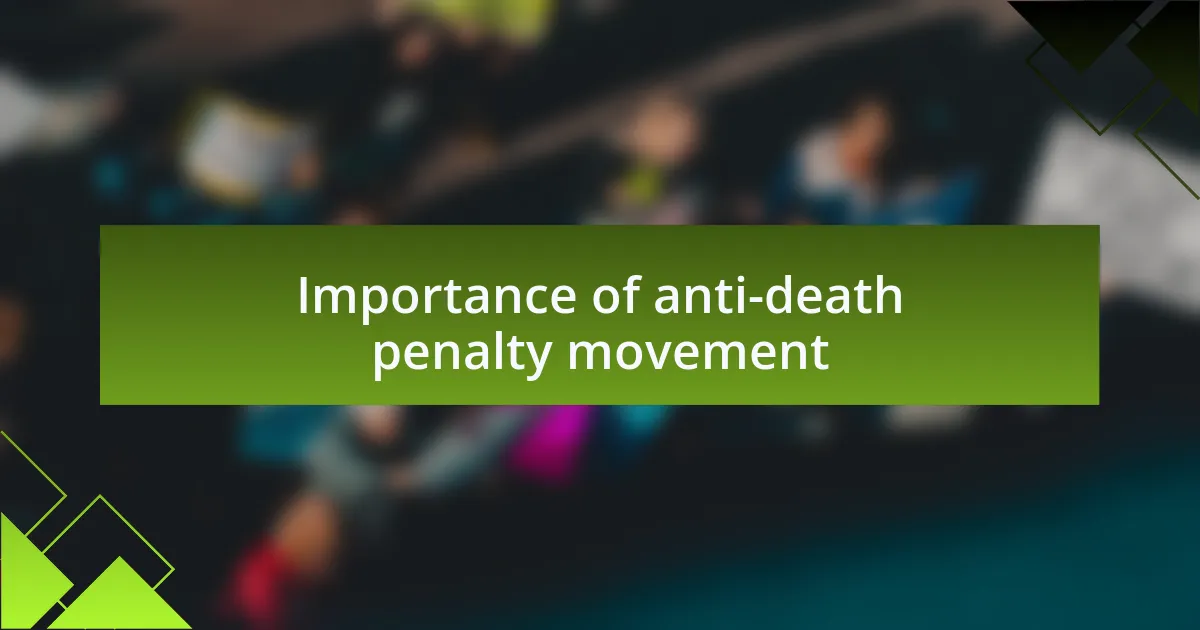
Importance of anti-death penalty movement
The anti-death penalty movement plays a crucial role in advocating for a justice system that values human life and dignity. I still remember a poignant conversation I had with a local activist who lost a loved one to violence but believed in forgiveness over vengeance. Hearing their perspective deeply challenged my own views, making me realize that the death penalty does not provide closure—rather, it perpetuates a cycle of pain and loss.
Another important aspect of this movement is its potential to address systemic inequities within the justice system. In my experience volunteering at a legal aid clinic, I saw how race, economic status, and access to resources significantly impacted sentencing. Why should someone’s fate be determined by these factors? The anti-death penalty movement highlights these disparities, pushing for reforms that prioritize fairness and equality for all individuals, regardless of background.
Furthermore, the movement encourages us to explore more humane and effective approaches to crime. I often reflect on the stories of individuals who have committed terrible acts but later demonstrated remarkable growth through programs focused on rehabilitation. Isn’t it worth considering how we can create a society that fosters redemption rather than retribution? By advocating against the death penalty, I believe we can reshape our narrative around justice to one that is restorative and hopeful.
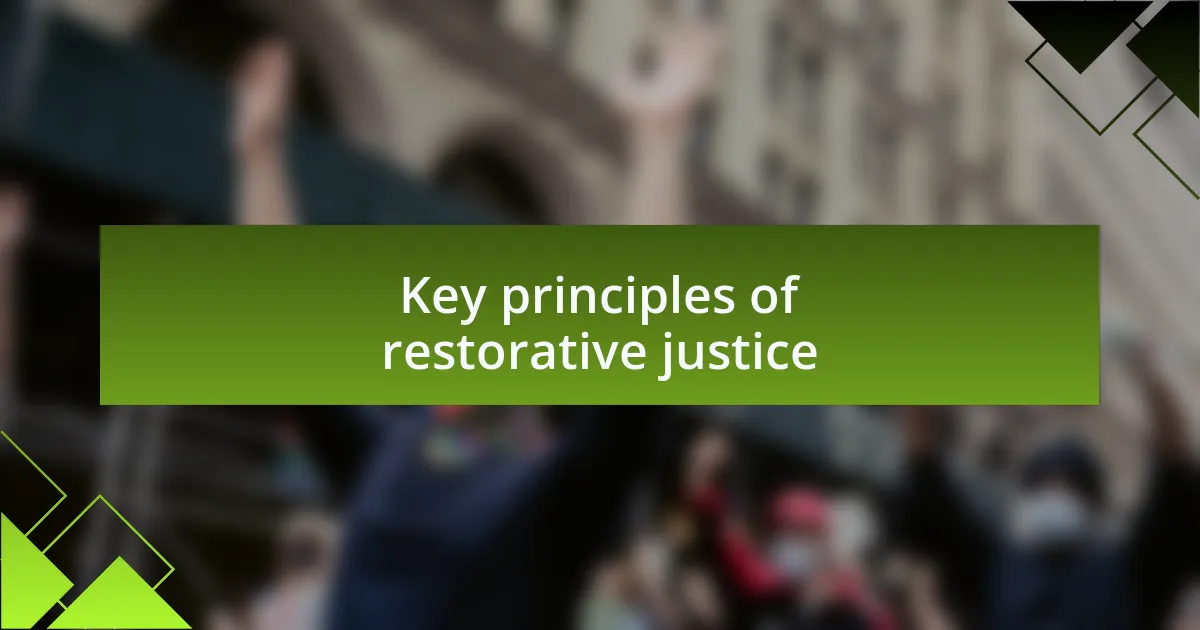
Key principles of restorative justice
Restorative justice revolves around the idea of repairing harm rather than punishing the offender. In my discussions with various victims and offenders, I’ve observed how facilitators create safe spaces for dialogue. It’s incredible to see individuals confront their actions and the impact on the victims, fostering a sense of empathy that can be transformative.
Another key principle is the involvement of all stakeholders in the justice process, including victims, offenders, and the community. Reflecting on a community circle I attended, I saw an offender express genuine remorse, while the victim shared how the crime had affected their life. This engagement goes beyond traditional justice; it gives everyone a voice, making the process collectively healing rather than divisive.
Lastly, restorative justice emphasizes accountability, but in a constructive way. From my experience, when offenders take responsibility for their actions, they unlock the potential for personal growth and change. Isn’t it more powerful to witness someone striving to make amends than to simply isolate them behind bars? This principle promotes a culture where healing is prioritized over punishment, paving the way for true reconciliation.
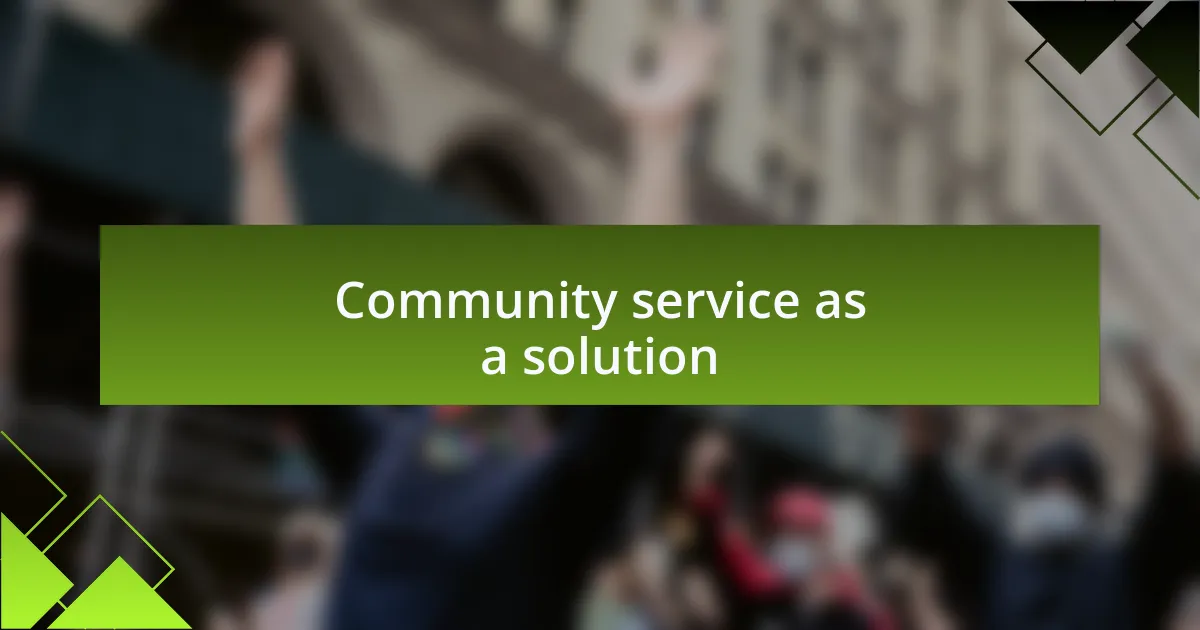
Community service as a solution
Community service represents a powerful alternative to incarceration, allowing offenders to contribute positively to their communities. I remember attending a local cleanup event where a group of young people, previously facing charges, were actively engaged in beautifying a neighborhood park. It struck me how mission-driven their efforts were, as they tackled the very spaces that might have once been marred by their actions.
This hands-on involvement doesn’t just benefit the community; it offers offenders a chance to reflect on their behaviors. I recall chatting with one participant who shared how the experience shifted his perspective. He felt a sense of pride in giving back, transforming his previous choices into lessons learned. Isn’t it refreshing to see someone turn their life around while making the world a bit better?
Moreover, community service enhances accountability in a way that punishment often fails to achieve. By facing the repercussions of their actions through service, individuals can directly witness the impact of their past while fostering relationships built on trust and respect. I’ve seen this firsthand, as relationships between offenders and community members often develop into supportive networks, promoting reintegration. It raises an essential question: what if we viewed community service as a stepping stone for personal redemption, rather than a mere consequence?
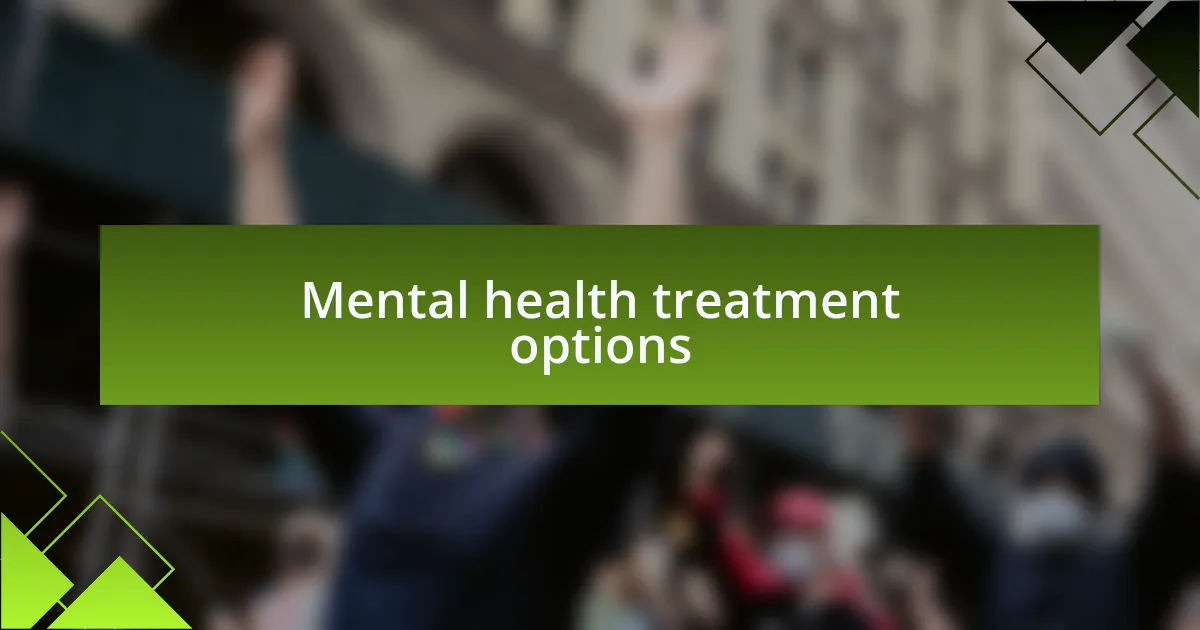
Mental health treatment options
Mental health treatment options play a crucial role in addressing the underlying issues that contribute to criminal behavior. I’ve seen firsthand how providing therapy and counseling can lead to profound transformations. One friend of mine battled substance abuse, often landing him in trouble with the law. It wasn’t until he participated in an intensive outpatient program that he began to really understand the roots of his struggles and how to manage them.
By prioritizing mental health care, we create a pathway for individuals to heal rather than simply punish them. I recall meeting a former inmate who shared that attending group therapy not only helped him process his emotions but also allowed him to connect with others who shared similar experiences. This sense of community was vital; it made him feel seen and understood in ways he hadn’t experienced before. How powerful is that, to feel connected in times of despair?
Additionally, access to mental health resources can significantly reduce recidivism rates. I once visited a facility where mental health support was integrated into rehabilitation programs, and the difference was palpable. Many participants expressed feeling empowered by the skills they learned to cope with stress and triggers. This rethink on addressing mental health can reshape the future for many. Wouldn’t it be something to envision a justice system that cares for individuals as whole people, not just offenders?
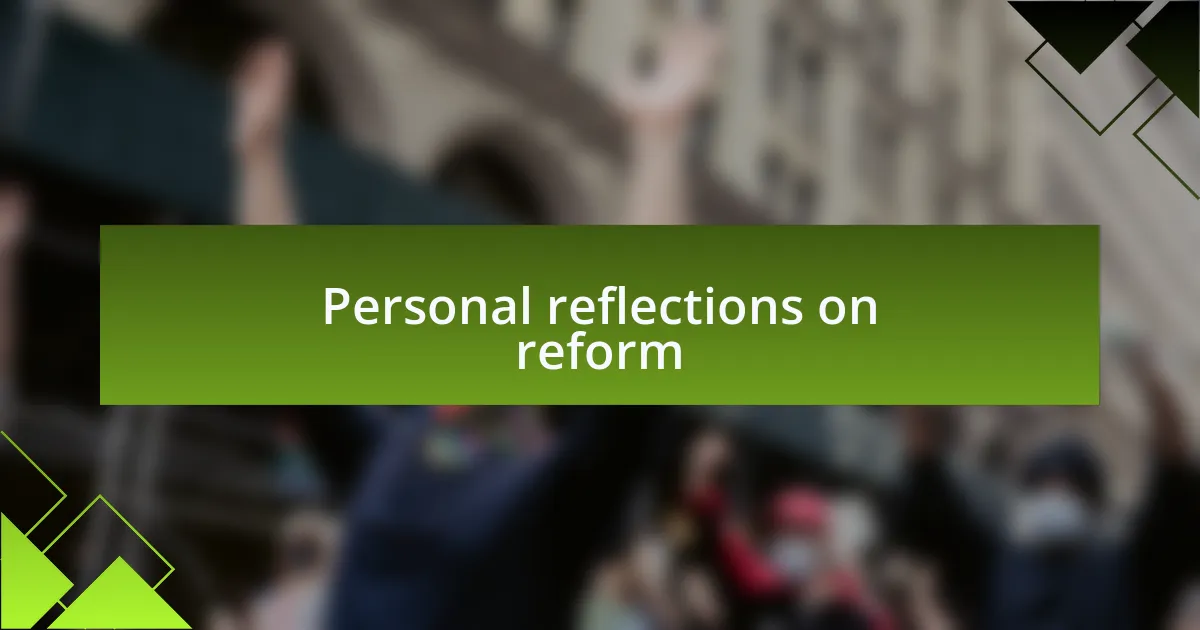
Personal reflections on reform
Reforming our approach to justice is something I find deeply important. I remember attending a community meeting where we discussed alternatives to incarceration. A speaker shared her experience of mentoring young people on probation, emphasizing empowerment instead of punishment. Hearing her passion made me realize how transformative education and mentorship can be in breaking the cycle of crime. Have you ever witnessed a single word of encouragement change someone’s life?
Another aspect that resonates with me is restorative justice. I encountered a program where victims met with offenders to share their stories and process the hurt caused. The emotional vulnerability on both sides was eye-opening—rather than building walls, they were fostering understanding. This experience left me wondering: shouldn’t we prioritize healing over retribution? It’s incredibly moving to see how these conversations can lead to accountability without reliance on punitive measures.
Ultimately, I believe our society has a choice to make. When I think about the countless lives affected by traditional incarceration, I feel compelled to advocate for reform. One poignant moment for me was meeting a former offender who redirected his life after participating in community service. He spoke about a renewed sense of purpose, igniting my hope for a justice system focused on rehabilitation. Isn’t it time we reinvent punitive practices into pathways for healing and growth?